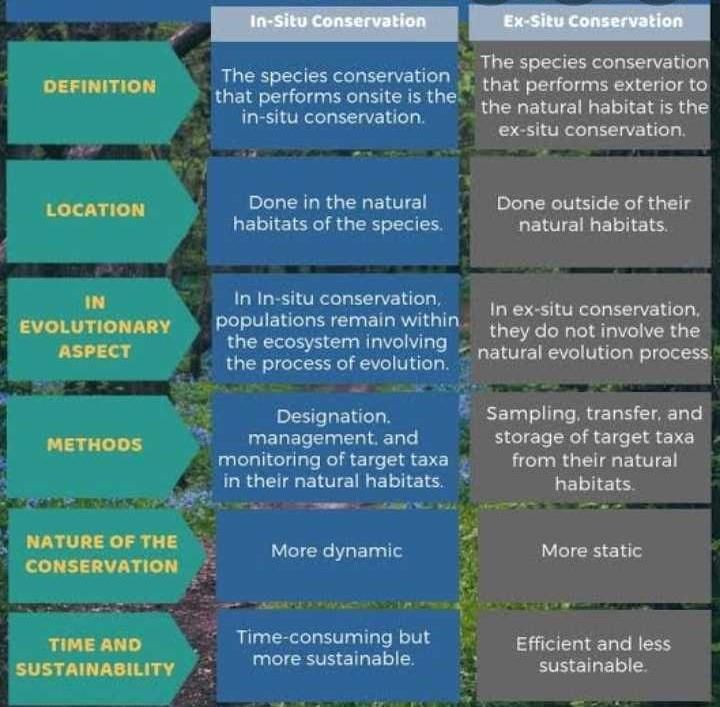NEET Exam > NEET Questions > What is the difference between ex situ and in...
Start Learning for Free
What is the difference between ex situ and in situ conservation?
Most Upvoted Answer
What is the difference between ex situ and in situ conservation?

Community Answer
What is the difference between ex situ and in situ conservation?
Ex Situ vs In Situ Conservation
Ex Situ Conservation:
- Ex situ conservation involves the preservation of species outside their natural habitat.
- This method is often used when species are facing immediate threats in their natural environment.
- Examples of ex situ conservation include zoos, botanical gardens, seed banks, and captive breeding programs.
- It allows for the protection and breeding of endangered species in a controlled environment.
- Ex situ conservation can help prevent extinction and provide a safety net for species at risk.
In Situ Conservation:
- In situ conservation involves the protection and management of species within their natural habitats.
- This method aims to maintain the ecological balance and biodiversity of ecosystems.
- Examples of in situ conservation include national parks, wildlife reserves, and protected areas.
- It focuses on preserving the natural habitats of species and allowing them to thrive in their original environment.
- In situ conservation is crucial for the long-term survival of species and the health of ecosystems.
Key Differences:
- Ex situ conservation is carried out outside the natural habitat, while in situ conservation is done within the natural habitat.
- Ex situ conservation is often a short-term solution for saving species, while in situ conservation focuses on long-term sustainability.
- Ex situ conservation can be costly and require intensive management, whereas in situ conservation relies on natural processes.
- Both methods are important for conservation efforts, and a combination of ex situ and in situ approaches is often needed to effectively protect species and ecosystems.
Ex Situ Conservation:
- Ex situ conservation involves the preservation of species outside their natural habitat.
- This method is often used when species are facing immediate threats in their natural environment.
- Examples of ex situ conservation include zoos, botanical gardens, seed banks, and captive breeding programs.
- It allows for the protection and breeding of endangered species in a controlled environment.
- Ex situ conservation can help prevent extinction and provide a safety net for species at risk.
In Situ Conservation:
- In situ conservation involves the protection and management of species within their natural habitats.
- This method aims to maintain the ecological balance and biodiversity of ecosystems.
- Examples of in situ conservation include national parks, wildlife reserves, and protected areas.
- It focuses on preserving the natural habitats of species and allowing them to thrive in their original environment.
- In situ conservation is crucial for the long-term survival of species and the health of ecosystems.
Key Differences:
- Ex situ conservation is carried out outside the natural habitat, while in situ conservation is done within the natural habitat.
- Ex situ conservation is often a short-term solution for saving species, while in situ conservation focuses on long-term sustainability.
- Ex situ conservation can be costly and require intensive management, whereas in situ conservation relies on natural processes.
- Both methods are important for conservation efforts, and a combination of ex situ and in situ approaches is often needed to effectively protect species and ecosystems.

|
Explore Courses for NEET exam
|

|
Similar NEET Doubts
What is the difference between ex situ and in situ conservation?
Question Description
What is the difference between ex situ and in situ conservation? for NEET 2025 is part of NEET preparation. The Question and answers have been prepared according to the NEET exam syllabus. Information about What is the difference between ex situ and in situ conservation? covers all topics & solutions for NEET 2025 Exam. Find important definitions, questions, meanings, examples, exercises and tests below for What is the difference between ex situ and in situ conservation?.
What is the difference between ex situ and in situ conservation? for NEET 2025 is part of NEET preparation. The Question and answers have been prepared according to the NEET exam syllabus. Information about What is the difference between ex situ and in situ conservation? covers all topics & solutions for NEET 2025 Exam. Find important definitions, questions, meanings, examples, exercises and tests below for What is the difference between ex situ and in situ conservation?.
Solutions for What is the difference between ex situ and in situ conservation? in English & in Hindi are available as part of our courses for NEET.
Download more important topics, notes, lectures and mock test series for NEET Exam by signing up for free.
Here you can find the meaning of What is the difference between ex situ and in situ conservation? defined & explained in the simplest way possible. Besides giving the explanation of
What is the difference between ex situ and in situ conservation?, a detailed solution for What is the difference between ex situ and in situ conservation? has been provided alongside types of What is the difference between ex situ and in situ conservation? theory, EduRev gives you an
ample number of questions to practice What is the difference between ex situ and in situ conservation? tests, examples and also practice NEET tests.

|
Explore Courses for NEET exam
|

|
Signup for Free!
Signup to see your scores go up within 7 days! Learn & Practice with 1000+ FREE Notes, Videos & Tests.
























